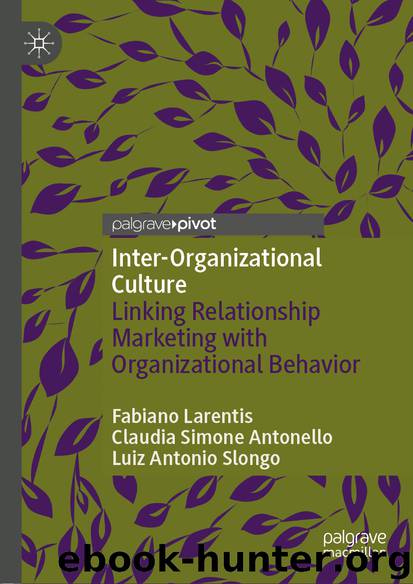Inter-Organizational Culture by Fabiano Larentis & Claudia Simone Antonello & Luiz Antonio Slongo

Author:Fabiano Larentis & Claudia Simone Antonello & Luiz Antonio Slongo
Language: eng
Format: epub
ISBN: 9783030003920
Publisher: Springer International Publishing
4.2 Role of Leadership and Boundary Spanners
The moment organizations decide to work together, they make a choice that will affect them in the long run, even if relationship is not successful. For those who realized that relationships are relevant for their strategies and processes, cultural changes will happen as result, in their diverse perspectives (Martin et al., 2006). We have an interpretative system which allows individuals to make sense of events and routine activities (Van Maane & Barley, 1985). On the other hand, role of leadership is to create conditions that allow results achievement, even partially, and make sense of these events later (Gagliardi, 1986).
Inter-organizational culture occurs between participants from different organizations, who share some meanings and symbols. However, inter-organizational culture, like relationships, is not excluding. It coexists with other cultures, in different cultural perspectives, because it is a product from these cultures and their interactions. It is a new form of culture stemming from relationships. On the other hand, inter-organizational culture is an intersection of cultures, with common spaces of symbols and meanings between different organizations. It may be seen as boundary culture.
In our research, we have identified that relationships affect cultural aspects due to the changes they will cause to organizational lives, taking into account the quantity and quality of interactions between different organizations, resources investments, trust and commitment formation between parts, cooperative practices, learning processes and results and capabilities formation. These changes will affect relationship continuity, as well as reduction boundary spanner role conflict and approximation between organizational areas, due to changes in point of views, ways to perceive world and interpretations from individuals from different organizations.
In turn, these shared cultural changes, presented by some people, groups or symbols and meanings, need relationships to be disseminated and get stronger. In Racon, a lot of franchisees got positively impressed with their management practices, mainly those associated with people and teams, while others got suspicious. Over time, they have incorporated these practices and, by consequence, their meanings, as far as they realize business results. In other words, we can perceive manifestations of inter-organizational culture, dependent on relationships.
Hence, relationships contribute to cultural changes between different companies. However, they depend on basic cultural elements because relationships depend on how much they are valued at the organizational level and rooted in organizational culture (Winklhofer, Pressey, & Tzokas, 2006). In the previous section, we consider the importance of relationship as reference and example to comprehend how to promote inter-organizational culture. However, we highlight that this importance needs to be absorbed in organizational practices and routines, i.e., to be presented in meanings and manifested in symbols, not only discourse and narratives, but also cooperative actions and results that convince and inspire people, mainly those in organizational boundaries, which serves not only to protect organization from environment, but also to establish patterns of connection between internal and external capabilities (Araujo, Dubois, & Gadde, 2003).
Organizational boundaries may be regarded as important places for learning and innovation, since they are socially built. Boundaries help to establish habits,
Download
This site does not store any files on its server. We only index and link to content provided by other sites. Please contact the content providers to delete copyright contents if any and email us, we'll remove relevant links or contents immediately.
| Direct | Global |
| Industrial | Multilevel |
| Product Management | Research |
| Telemarketing | Web Marketing |
Influence: The Psychology of Persuasion by Robert B. Cialdini(4736)
The Miracle Morning by Hal Elrod(4675)
The Hacking of the American Mind by Robert H. Lustig(4338)
Pre-Suasion: A Revolutionary Way to Influence and Persuade by Robert Cialdini(4183)
Unlabel: Selling You Without Selling Out by Marc Ecko(3625)
Ogilvy on Advertising by David Ogilvy(3552)
Hidden Persuasion: 33 psychological influence techniques in advertising by Marc Andrews & Matthijs van Leeuwen & Rick van Baaren(3518)
Purple Cow by Seth Godin(3167)
Who Can You Trust? by Rachel Botsman(3111)
Kick Ass in College: Highest Rated "How to Study in College" Book | 77 Ninja Study Skills Tips and Career Strategies | Motivational for College Students: A Guerrilla Guide to College Success by Fox Gunnar(3099)
The Marketing Plan Handbook: Develop Big-Picture Marketing Plans for Pennies on the Dollar by Robert W. Bly(3005)
This Is Marketing by Seth Godin(2993)
I Live in the Future & Here's How It Works by Nick Bilton(2960)
The Power of Broke by Daymond John(2932)
The Tipping Point by Malcolm Gladwell(2870)
Building a StoryBrand by Donald Miller(2862)
The 46 Rules of Genius: An Innovator's Guide to Creativity (Voices That Matter) by Marty Neumeier(2817)
Draw to Win: A Crash Course on How to Lead, Sell, and Innovate With Your Visual Mind by Dan Roam(2756)
Market Wizards by Jack D. Schwager(2670)
